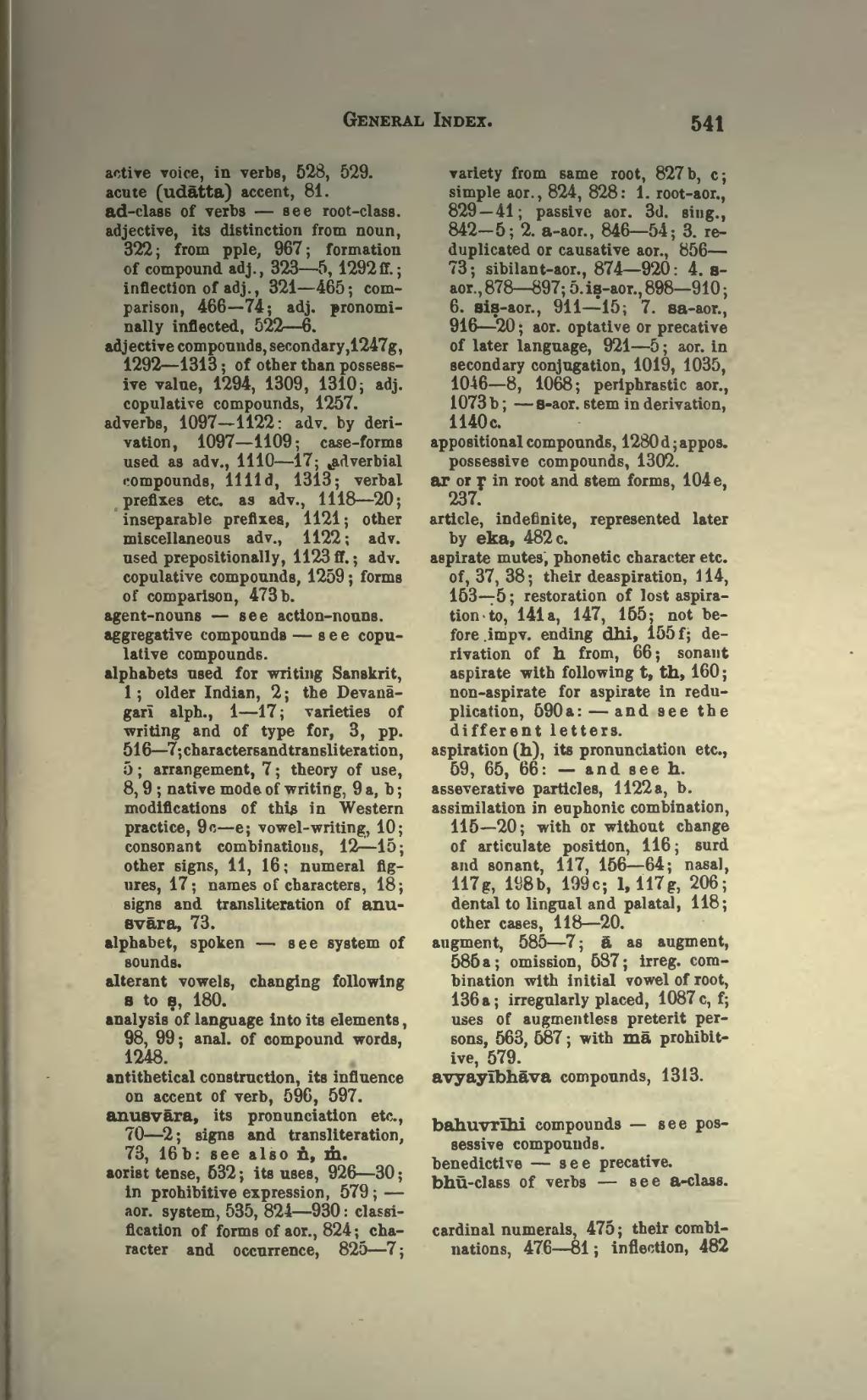active voice, in verbs, 528, 529.
acute (udātta) accent, 81.
ad-class of verbs — see root-class.
adjective, its distinction from noun, 322; from pple, 967; formation of compound adj., 323–5, 1292 ff.; inflection of adj., 321–465; comparison, 466–74; adj. pronominally inflected, 522–6.
adjective compounds, secondary, 1247 g, 1292–1313; of other than possessive value, 1294, 1309, 1310; adj. copulative compounds, 1257.
adverbs, 1097–1122: adv. by derivation, 1097–1109; case-forms used as adv., 1110–17; adverbial compounds, 1111 d, 1313; verbal prefixes etc. as adv., 1118–20; inseparable prefixes, 1121; other miscellaneous adv., 1122; adv. used prepositionally, 1123 ff.; adv. copulative compounds, 1259; forms of comparison, 473 b.
agent-nouns — see action-nouns.
aggregative compounds — see copulative compounds.
alphabets used for writing Sanskrit, 1; older Indian, 2; the Devanāgarī alph., 1–17; varieties of writing and of type for, 3, pp. 516–7; characters and transliteration, 5; arrangement, 7; theory of use, 8, 9; native mode of writing, 9 a, b; modifications of this in Western practice, 9 c–e; vowel-writing, 10; consonant combinations, 12–15; other signs, 11, 16; numeral figures, 17; names of characters, 18; signs and transliteration of anusvāra, 73.
alphabet, spoken — see system of sounds.
alterant vowels, changing following s to ṣ, 180.
analysis of language into its elements, 98, 99; anal. of compound words, 1248.
antithetical construction, its influence on accent of verb, 596, 597.
anusvāra, its pronunciation etc., 70–2; signs and transliteration, 73, 16 b: see also ṅ, ṁ.
aorist tense, 532; its uses, 926–30; in prohibitive expression, 579; — aor. system, 535, 824–930: classification of forms of aor., 824; character and occurrence, 825–7; variety from same root, 827 b, c; simple aor., 824, 828: 1. root-aor., 829–41; passive aor. 3d. sing., 842–5; 2. a-aor., 846–54; 3. reduplicated or causative aor., 856–73; sibilant-aor., 874–920; 4. s-aor., 878–897; 5. iṣ-aor., 898–910; 6. siṣ-aor., 911–15; 7. sa-aor., 916–20; aor. optative or precative of later language, 921–5; aor. in secondary conjugation, 1019, 1035, 1046–8, 1068; periphrastic aor., 1073 b; — s-aor. stem in derivation, 1140 c.
appositional compounds, 1280 d; appos. possessive compounds, 1302.
ar or ṛ in root and stem forms, 104 e, 237.
article, indefinite, represented later by eka, 482 c.
aspirate mutes, phonetic character etc. of, 37, 38; their deaspiration, 114, 153–5; restoration of lost aspiration to, 141 a, 147, 155; not before impv. ending dhi, 155 f; derivation of h from, 66; sonant aspirate with following t, th, 160; non-aspirate for aspirate in reduplication, 590 a: — and see the different letters.
aspiration (h), its pronunciation etc., 59, 65, 66: — and see h.
asseverative particles, 1122 a, b.
assimilation in euphonic combination, 115–20; with or without change of articulate position, 116; surd and sonant, 117, 156–64; nasal, 117 g, 198 b, 199 c; l, 117 g, 206; dental to lingual and palatal, 118; other cases, 118–20.
augment, 585–7; ā as augment, 585 a; omission, 587; irreg. combination with initial vowel of root, 136 a; irregularly placed, 1087 c, f; uses of augmentless preterit persons, 563, 587; with mā prohibitive, 579.
avyayībhāva compounds, 1313.
bahuvrīhi compounds — see possessive compounds.
benedictive — see precative.
bhū-class of verbs — see a-class.
cardinal numerals, 475; their combinations, 476–81; inflection, 482-
